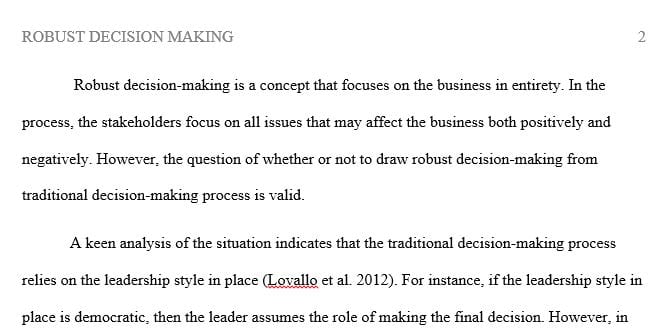The question that the stakeholders should ask is whether or not robust decisions will be drawn from the traditional to the future.
Robust Decision
The recent evolution in the field of system dynamics, modelling, and simulation are expected to integrate further in fields, such as computer science, machine learning, and data analysis. In addition, there are gaps that need to be filled in order for decision-makers who face uncertain issues to meet their expectations (Janssen, Wimmer, & Deljoo 2015). The robust decision behavior of future decision-makers may also be difficult to incorporate in simulation. Furthermore, robust decision-making tends to address challenges by analyzing and reframing analytic decisional analysis from a predict then act perspective. Comparing robust decision making to other fields is, therefore, important since it brings a distinct image of the near future.
Robust Decision-making also uses a direct path, rather than an optimal criterion. This fact is meant to address alternative policies. Kwakkel, Walker, and Haasnoot (2016) argue thatdecision options become contingent on the best probability options, which provide the decision makers with the best issues concerning the issue at hand. Additionally, robust decisions provide a set of options over a narrow range of available scenarios. Robust Decisions also employ a vulnerability and response framework, as an option to help identify the best strategies. Strong decisions are also made to determine the uncertainties that may be beyond the control of the top decision-makers. Additionally, robust decisions analyze the future with a point of focus.
Robust decisions may be difficult to make in a quantitative form to support applications. Furthermore, simulation basically depends on how the system will respond to the policy interventions and the researchers in the long-run (Janssen, Wimmer, & Deljoo, 2015). Decision makers should also adapt proper robust decision strategies, such as model socio-economic behavior and those expressed by the future stakeholders. Therefore, the question that the stakeholders should ask is whether or not robust decisions will be drawn from the traditional to the future. Provide your viewpoint and provide supporting documentation.
References
Janssen, M., Wimmer, M. A., & Deljoo, A. (Eds.). (2015). policy practice and digital science: integrating complex systems, social simulation and public administration in policy research (Vol. 10). Cham, Switzerland: Springer.
Kwakkel, J. H., Walker, W. E., & Haasnoot, M. (2016). Coping with the wickedness of public policy problems: approaches for decision making under deep uncertainty.
** Please go through above post and answer the discussion**
1. Therefore, the question that the stakeholders should ask is whether or not robust decisions will be drawn from the traditional to the future. Provide your viewpoint and provide supporting documentation. (500 words min)
2. Reply with 50-100 words for above post
Instructions:
At least 500 words
And a reply with 50-100 words for above post
Must be in APA Style
Must Have 3 Peer Reviewed Works/Article
Solution preview for the order on the question that the stakeholders should ask is whether or not robust decisions will be drawn from the traditional to the future.
APA
677 words
